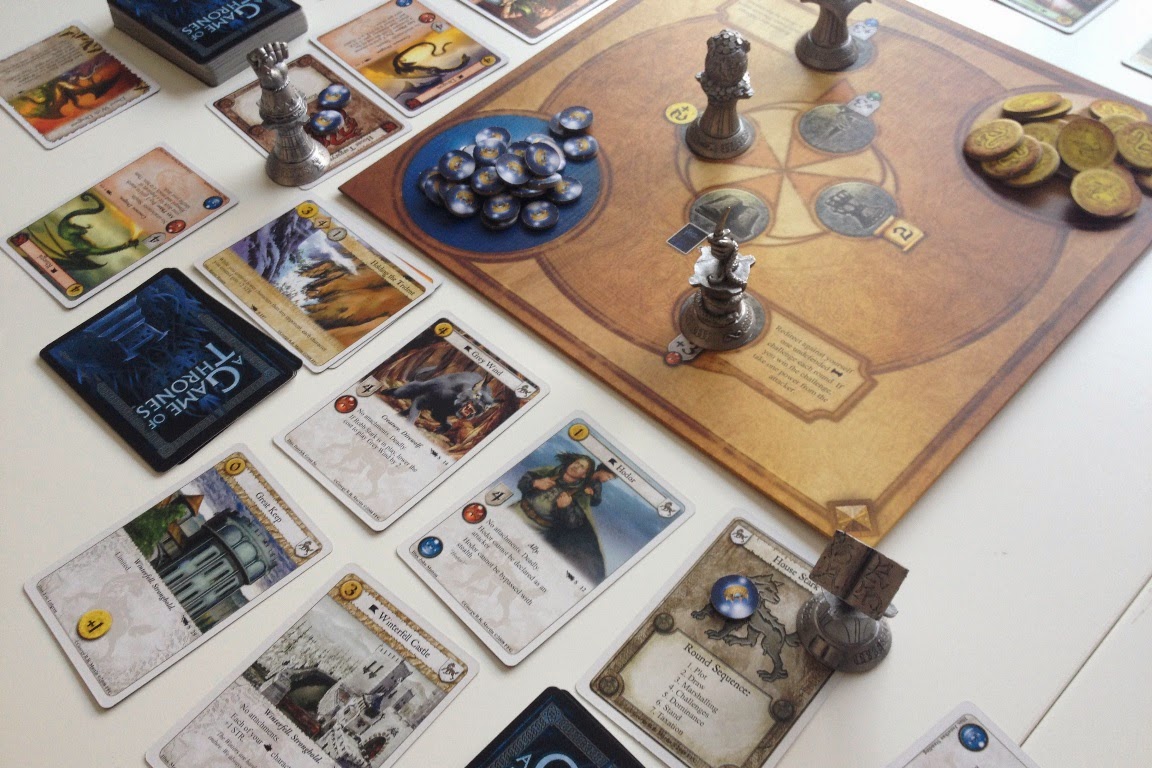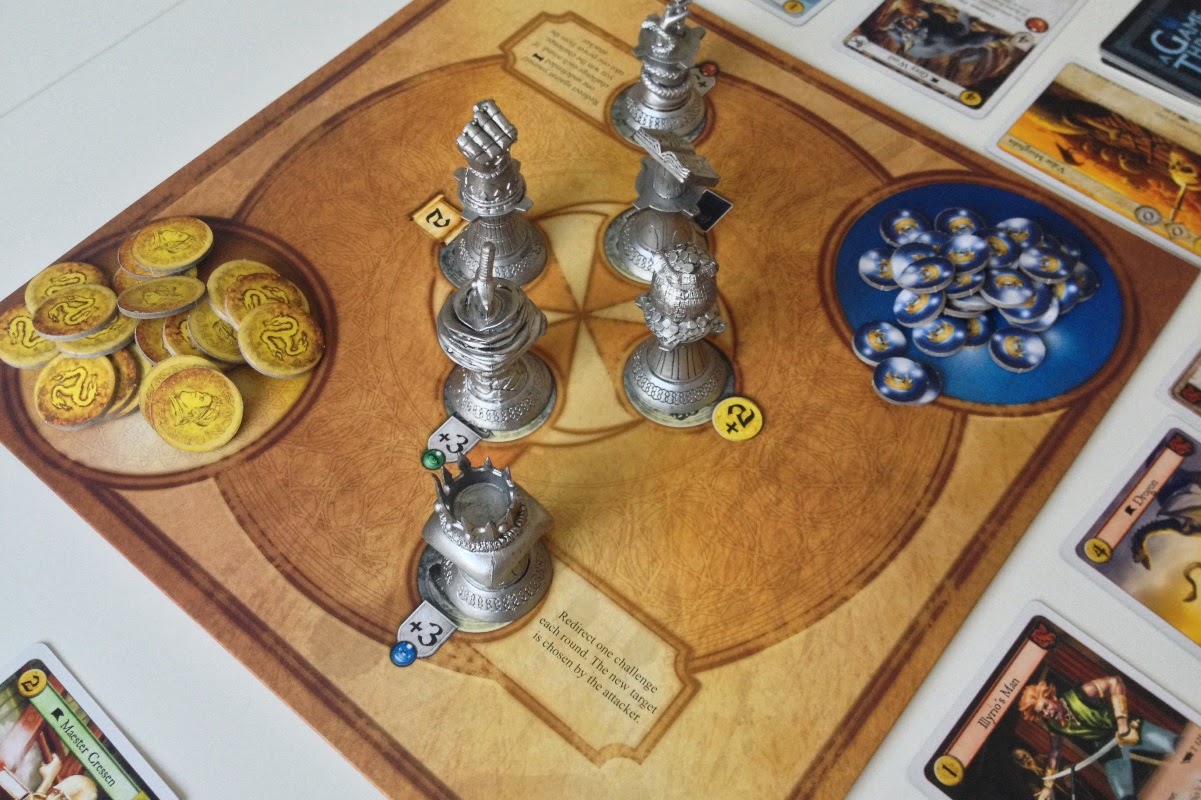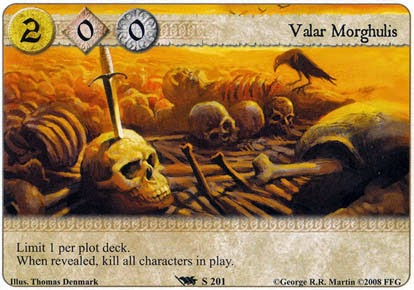A long time ago, long before the idea of a Game of Thrones television program began to form, there was a tabletop gaming arms race. Collectible Card Games (CCGs) where the game of the moment, the success of Magic the Gathering and Pokémon had proven that combining the concept of trading cards with tabletop games could be a huge money spinner. This created a rush to convert every single licence into a CCG and rake in the cash. George R R Martin’s ‘A Song of Ice and Fire’ series was no exception and in 2002 A Game of Thrones the collectable card game was released with much praise. Fast forward to 2008 and the rampant growth of CCGs has been trimmed back to a chosen few and Fantasy Flight Games convert the existing CCG game into one of their living card games; like collectible card games but with standardised releases rather than random booster packs.And that leads us today, when the ‘Song of Ice and Fire’ is more popular than it’s ever been and the question you’re asking is “is this Game of Thrones card game worth playing?” and I’m here to say, yes but with a few caveats.
A Game of Thrones lets you play between two and four players and actually presents a slightly different game with each player count. At two players, the game plays out in the typical CCG format, with players utilising their deck to beat their opponent head to head. Increase to three and four player games and there are also titles; miniatures that the player claims and gives a bonus for the rest of the turn and allows them to politically manoeuvre and protect themselves from other players.
Let’s get this straight from the start; the core set is just a beginner box. Although four houses are included in the game, this is intended as a starter into the living card game system. The core set is playable as a standalone product but suffers from balance issues, especially when played with two players. To get the most out of this game you are going to have to customise the supplied decks or create your own decks, and to do this you’re going to have to buy more cards. You could buy one of the many expansions or even a second core set, but this means that you have to decide if a CCG is for you and your friends.
Each turn starts by players selecting a plot that will affect play for the rest of the turn. Plot cards include a value for income, initiative and the size of the reward you get for winning challenges. The plot card chosen can have a significant effect on the rest of the turn and a player’s hand of plot cards has to be fully used before they can be used again. Plot decks represent a second small deck of cards that players customise and manage. It’s a neat little twist and although cards like the dreaded Valar Morgulis can be powerful, creating a balanced set of 7 cards is just as intriguing as building your main play deck.
The plot cards govern many things, one of them being your income for the round, gold being the currency to buy new cards into play but also important for decided dominance but more on that later.
The challenge phase is the main section of the game. During this phase each player can make up to 3 challenges; one each of combat, intrigue and power. To do this a player selects the type of challenge, selects which characters are taking part and then ‘kneels’ the character card (turn then 90°) to show they are out of action. The defending player can then oppose the challenge by kneeling defending characters and whoever has the highest total strength wins. The effect of a successful challenge depends on the type of challenge issued; military challenges kill characters, intrigue forces the defender to discard cards from their hands and power challenges allow the winner to steal power from their opposition.
The domination phase is simply a count up of standing characters and unspent gold. Whoever has the highest score wins a power point for their house. Power is the victory point system in the game as the first player to reach 15 power points is the winner. During early turns of the game power is in short supply and takes a few turns to build up steam. There are other ways for players to gain power, some characters can gain it for themselves but if they die that power is lost and if any challenge is unopposed then the house also wins a power. It is still very much in short supply and especially in early games 15 seems like a staggeringly large amount to have to gain. Many games I’ve played have been cut short as we decided to finish once the plot decks have been exhausted, cutting the game down to 7 turns.
If you’re at all familiar with Magic the Gathering you’ll start to recognise some mechanics and there’s a lot of common DNA between them. However, A Game of Thrones is a level of complexity above Magic. There is a lot more to keep track of, making sure you can defend against all kinds of challenge, no overusing your resources and getting your more powerful cards into play.
Where A Game of Thrones The Card Game spectacularly fails to deliver is the rule book. It starts by explaining how to play the full 4 player game and at the end of the book there are variants for 2 and 3 player games. The whole game would be easier to understand if it started with 2 player then introduce the titles mechanics later. It makes a brief reference to Agendas and then gives you no examples of what they are and never mentions them again. It doesn’t even include all the rules for all of the cards in the core set (what does the infinity symbol mean?). It doesn’t give any explanation on how the LCG format works, what expansions you should buy next and a pitifully small section how to construct a deck that barely covers the basics. Taking this further it misses out some rules completely. For example let’s say you bought a random chapter pack to buy some extra cards these chapter packs reference rules that aren’t included in the base game e.g. shadow cards and the seasons mechanic. Now it is understandable that some of these rules came into play after the core set was released and many of these rules can be downloaded from Fantasy Flight Games and Board Game Geek but it’s now a six years since the game’s initial release so why aren’t these rules now included in the box?
For a card game A Game of Thrones does a pretty solid job of sticking to its theme. You’re constantly jostling for supremacy, battling on a number of fronts and often straight up combat isn’t the way forward. Although the 3 and 4 player rules make the game more complicated, perhaps unnecessarily so, it further strengthens the Westeros principles of backstabbing and treachery. The card game also represents an interesting counterpoint to A Game of Thrones the board game, where the board game feels like a military struggle to take control of territory, the card game is a lot more personal. If the board game where to represent the fields of battle embodied in the books, the card game suitably replicates the stabbings, poisonings and barbed tongues that exemplify most of what a Song of Ice and Fire is about.
It’s just a problem that A Game of Thrones is so bloody hard to get your head around. There’s no denying it’s a complicated rule set and, as with most card games, every single card in play adds another layer of complexity to the game in progress. It does mean that once the rules are mastered there is a significant amount of depth. On offer are immense arrays of strategic and tactical options, starting the moment you customise your first deck. There are hundreds of cards available to strengthen and tweak your deck, as well as two extra houses if the original four aren’t to your taste. All this creates a game of almost limitless possibility at its core but only once you’ve broken through extremely thick defences.
A Game of Thrones The Card Game is an extremely meaty game but there is a significant barrier to entry. It lacks the simplicity of Magic or the sexy sleekness of Netrunner but it makes up for this in its depth. It really is a complicated and deep game for a CCG and subsequently it’s going to take some commitment to get the most out of it and this is A Game of Thrones greatest flaw. Many players are going to put off by A Game of Thrones’ steep learning curve and complexity but those players who are looking for a collectible card game to really sink their teeth into are going to be richly rewarded.







Comments
Post a Comment